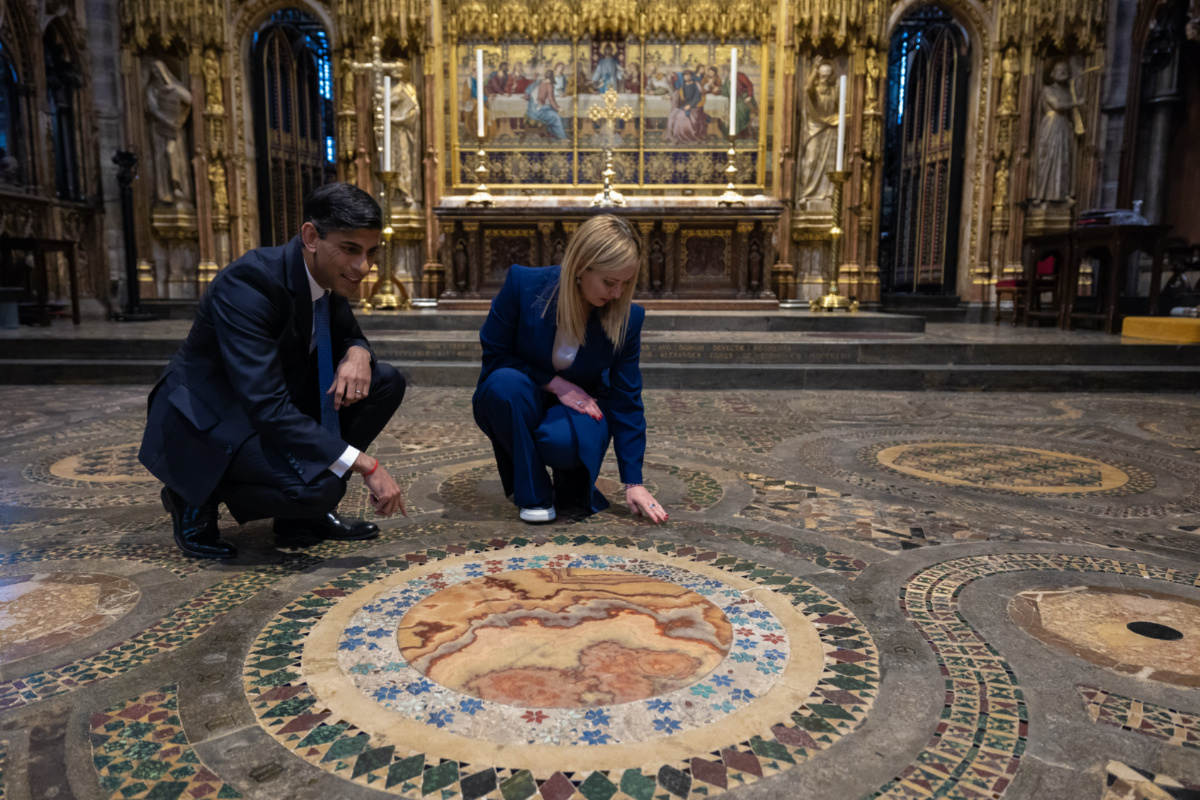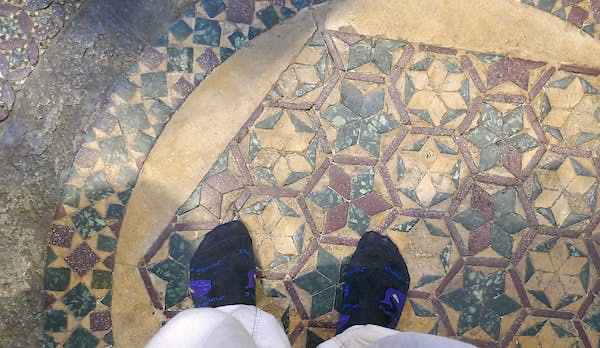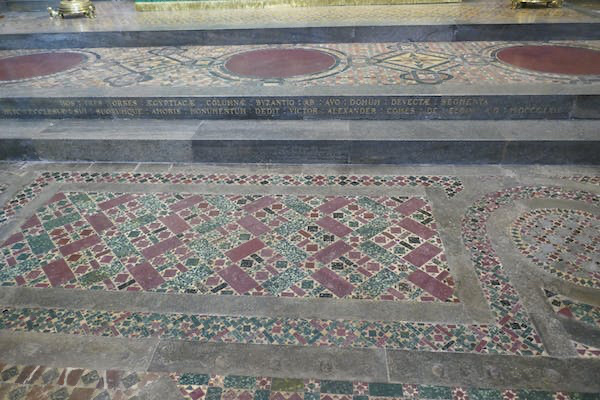
LIZ JAMES, an art historian and mosaic expert, talks about her walk upon to Westminster’s Abbey’s famed medieval floor…
In the months before King Charles III was crowned on 6th May 2023, Westminster Abbey announced that the public would be able to see its fabled Cosmati pavement up close – in their socks.
The 13th-century mosaic floor had been covered up by thick carpets to protect it for as long as anyone alive could remember. The guided tour dates sold out within 24 hours. Visitors jumped at this chance to collect the dust of ages on their feet and take it home.

UK Prime Minister Rishi Sunak visits Westminster Abbey in London with the Prime Minister of Italy Giorgia Meloni where they were shown the Cosmati Pavement on 27th April, 2023. PICTURE: Simon Walker / No 10 Downing Street (licensed under CC BY-NC-ND 2.0)
I went in July. On the day, I chose my socks very carefully. Black, with a repeating pattern of Jonah and the whale in blue and yellow, a little something from the Wells Cathedral giftshop.
The Cosmati pavement, of course, played a stellar role during the coronation ceremony. It is the floor on which the king was literally crowned and across which, most memorably, Lord President of the Council Penny Mordaunt walked and stood guard, carrying two antique swords vertically out in front of her while balancing on undeniably high heels.

The author’s Jonah and the whale socks. PICTURE: Liz James
As an art historian and mosaic expert, I found the experience of walking on this medieval treasure myself to be brilliant. Not so much for following in Mordaunt’s footsteps – her feat of endurance notwithstanding – but for the encounter with the floor itself.
Intricate patterns
Up close, the first thing you notice is that the stones feel cool underfoot and the pavement is not flat. I suspect it would have been much flatter in the 13th century. But time and wear and restorations have made it uneven. That adds to the visitor’s sensations. You explore the complex, bewildering patterning with your feet as well as with your eyes.
These stonework patterns are what make the pavement the most fabulous thing. Overhead aerial photographs show the floor in all its glory. The central portion comprises circles arranged in a quincunx (four points at the corner of a square and one in the middle, like the five on a die). The border counts five circles strung around each corner with single rectangular panels between the corner groupings.
Up close, however, what strikes you are the intricacies of the patterning within each of these elements as well as the almost psychedelic alternations of colours and the dazzling effect this has on the eyes. It is almost like looking at a kaleidoscopic Bridget Riley painting.
This floor, when first laid, would have shimmered and moved, almost like a silk carpet (but not as soft). Whatever the possible meanings of the designs, or the links with Rome and the Papacy, this is what people would have experienced and felt first in the abbey. After the most recent restoration work, between 2008 and 2010, the abbey’s head conservator Vanessa Simeoni reportedly said: “When this floor was new it would have blazed with colour. The materials were chosen for their brilliance and shine, and the quality of the craftsmanship is actually shocking, the ultimate that could be achieved.”
None of the patterns are quite the same: there is surprisingly little uniformity. The stones subtly change in size, shape and the alternation of colours.
Centuries of wear
The floor as we have it now is not all 13th century. There have been various interventions and restorations, most notably by Sir George Gilbert Scott between 1859 and 1871. As Simeoni has observed, one of the hardest things in the restoration process was working out what pattern went where and what to put in those areas where whole sections had been lost.

The Latin inscription on the steps to the High Altar. PICTURE: Liz James
The pavement around the high altar is Scott’s work (and design). He used large discs of purple porphyry presented by Lord Elgin (of Parthenon marbles fame) and commemorated with a Latin inscription along the edge of the middle step of the altar platform.
The central rectangle of the eastern border is also Scott’s work. It is good and thoughtful restoration, with considerable effort taken to match the stones. By standing above it, you can make out how the marble is slightly different in colour, slightly more regular in its cut (presumably the difference between hand-cut in the 13th century and machine-cut in the 19th), and much smoother and flatter than the earlier bits of the pavement. As Simeone points out, however, Scott cut the stones too thinly and so they will work loose.
We rely on our readers to fund Sight's work - become a financial supporter today!
For more information, head to our Subscriber's page.
Elsewhere, in earlier restorations, there are places where green serpentine (from the Lizard in Cornwall) has replaced green porphyry, red Belgian marble and black Belgian marble have been used. In the 2008 restoration, where the original Purbeck marble had deteriorated too far as a result of damp conditions, new pieces of Purbeck, this time from Dorset, were introduced.
The marble is the basic material used for the matrix, the lines holding the pattern together. It polishes up beautifully. From close up you can see the fossilised shells of which it is comprised.
PREVIOUSLY: Great Works: The Cosmati Pavement
What is also not clear until you are on the floor are the issues in conservation that remain. Two key areas – decorated tomb covers to the left and right of the floor – are exactly where seating for the clergy needs to be when the abbey is used for worship. Heavy Victorian benches had caused considerable damage.
During the conservation work between 2008 and 2010, protective floor coverings called “eyemats” – printed with full-sized images of the mosaic – were placed over the tomb covers. New lighter furniture is now in use.
The story goes that the carpets with which the floor was covered until 2008 were first laid down for Queen Mary (wife of George V), who insisted on wearing heels across the pavement. What I wanted to know, though, was whether Mordaunt’s heels had damaged the floor. I suspect I wasn’t the first or the last to ask this question. The reply was a model of tact and diplomacy.
Actually, my socks were in good condition afterwards. It turns out that the dust of ages is in short supply.
The floor is regularly vacuumed to remove debris, and the surface – which has been waxed both to protect the stones and to heighten their patina – is buffed weekly and before major events – not too much to create a skid hazard, but enough to keep the stones glimmering.![]()
Liz James is professor of history of art at University of Sussex. This article is republished from The Conversation under a Creative Commons license. Read the original article.






